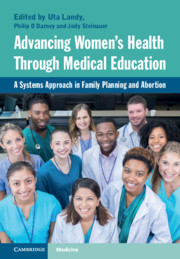 Advancing Women's Health Through Medical Education
Advancing Women's Health Through Medical Education from Section I - Abortion Training: Workforce, Leadership, Social & Political Impact
Published online by Cambridge University Press: 30 July 2021
The first reforms in health education occurred in response to the publication of the Flexner Report in 1910, more than a hundred years ago [1]. The reforms, sparked by the discovery of the germ theory in Europe and other scientific advances, led to the integration of early developments in medical science into the academic education of physicians. Ten years ago, the Lancet published a report, “Health Professionals for a New Century: Transforming Education to Strengthen Health Systems in an Interdependent World,” based on the findings of a global independent commission to address the inequities in health, despite enormous scientific advances in medicine [2]. In this report, twenty professional and academic leaders representing the perspective of diverse countries defined an educational strategy for medicine, nursing and public health. Its intention was to consider the relationship between health systems and education and recommend strategies to produce a workforce that addresses the health needs of a particular country.
To save this book to your Kindle, first ensure [email protected] is added to your Approved Personal Document E-mail List under your Personal Document Settings on the Manage Your Content and Devices page of your Amazon account. Then enter the ‘name’ part of your Kindle email address below. Find out more about saving to your Kindle.
Note you can select to save to either the @free.kindle.com or @kindle.com variations. ‘@free.kindle.com’ emails are free but can only be saved to your device when it is connected to wi-fi. ‘@kindle.com’ emails can be delivered even when you are not connected to wi-fi, but note that service fees apply.
Find out more about the Kindle Personal Document Service.
To save content items to your account, please confirm that you agree to abide by our usage policies. If this is the first time you use this feature, you will be asked to authorise Cambridge Core to connect with your account. Find out more about saving content to Dropbox.
To save content items to your account, please confirm that you agree to abide by our usage policies. If this is the first time you use this feature, you will be asked to authorise Cambridge Core to connect with your account. Find out more about saving content to Google Drive.